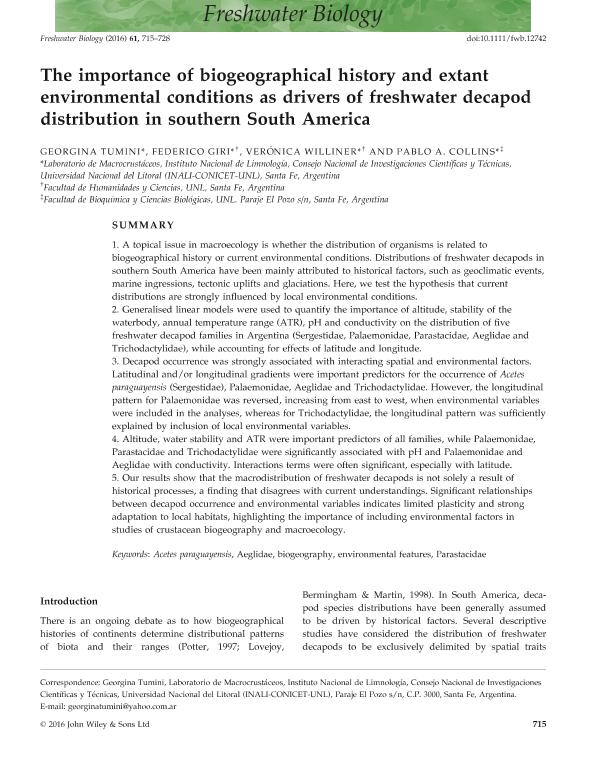Mostrar el registro sencillo del ítem
dc.contributor.author
Tumini, Georgina

dc.contributor.author
Giri, Federico

dc.contributor.author
Williner, Verónica

dc.contributor.author
Collins, Pablo Agustin

dc.date.available
2018-09-16T15:01:40Z
dc.date.issued
2016-05
dc.identifier.citation
Tumini, Georgina; Giri, Federico; Williner, Verónica; Collins, Pablo Agustin; The importance of biogeographical history and extant environmental conditions as drivers of freshwater decapod distribution in southern South America; Wiley Blackwell Publishing, Inc; Freshwater Biology (print); 61; 5; 5-2016; 715-728
dc.identifier.issn
0046-5070
dc.identifier.uri
http://hdl.handle.net/11336/59822
dc.description.abstract
A topical issue in macroecology is whether the distribution of organisms is related to biogeographical history or current environmental conditions. Distributions of freshwater decapods in southern South America have been mainly attributed to historical factors, such as geoclimatic events, marine ingressions, tectonic uplifts and glaciations. Here, we test the hypothesis that current distributions are strongly influenced by local environmental conditions. Generalised linear models were used to quantify the importance of altitude, stability of the waterbody, annual temperature range (ATR), pH and conductivity on the distribution of five freshwater decapod families in Argentina (Sergestidae, Palaemonidae, Parastacidae, Aeglidae and Trichodactylidae), while accounting for effects of latitude and longitude. Decapod occurrence was strongly associated with interacting spatial and environmental factors. Latitudinal and/or longitudinal gradients were important predictors for the occurrence of Acetes paraguayensis (Sergestidae), Palaemonidae, Aeglidae and Trichodactylidae. However, the longitudinal pattern for Palaemonidae was reversed, increasing from east to west, when environmental variables were included in the analyses, whereas for Trichodactylidae, the longitudinal pattern was sufficiently explained by inclusion of local environmental variables. Altitude, water stability and ATR were important predictors of all families, while Palaemonidae, Parastacidae and Trichodactylidae were significantly associated with pH and Palaemonidae and Aeglidae with conductivity. Interactions terms were often significant, especially with latitude. Our results show that the macrodistribution of freshwater decapods is not solely a result of historical processes, a finding that disagrees with current understandings. Significant relationships between decapod occurrence and environmental variables indicates limited plasticity and strong adaptation to local habitats, highlighting the importance of including environmental factors in studies of crustacean biogeography and macroecology.
dc.format
application/pdf
dc.language.iso
eng
dc.publisher
Wiley Blackwell Publishing, Inc

dc.rights
info:eu-repo/semantics/openAccess
dc.rights.uri
https://creativecommons.org/licenses/by-nc-sa/2.5/ar/
dc.subject
ACETES PARAGUAYENSIS
dc.subject
AEGLIDAE
dc.subject
BIOGEOGRAPHY
dc.subject
ENVIRONMENTAL FEATURES
dc.subject
PARASTACIDAE
dc.subject.classification
Otras Ciencias Biológicas

dc.subject.classification
Ciencias Biológicas

dc.subject.classification
CIENCIAS NATURALES Y EXACTAS

dc.title
The importance of biogeographical history and extant environmental conditions as drivers of freshwater decapod distribution in southern South America
dc.type
info:eu-repo/semantics/article
dc.type
info:ar-repo/semantics/artículo
dc.type
info:eu-repo/semantics/publishedVersion
dc.date.updated
2018-09-14T13:21:43Z
dc.journal.volume
61
dc.journal.number
5
dc.journal.pagination
715-728
dc.journal.pais
Reino Unido

dc.journal.ciudad
Londres
dc.description.fil
Fil: Tumini, Georgina. Consejo Nacional de Investigaciones Científicas y Técnicas. Centro Científico Tecnológico Conicet - Santa Fe. Instituto Nacional de Limnología. Universidad Nacional del Litoral. Instituto Nacional de Limnología; Argentina
dc.description.fil
Fil: Giri, Federico. Universidad Nacional del Litoral. Facultad de Humanidades y Ciencias; Argentina. Consejo Nacional de Investigaciones Científicas y Técnicas. Centro Científico Tecnológico Conicet - Santa Fe. Instituto Nacional de Limnología. Universidad Nacional del Litoral. Instituto Nacional de Limnología; Argentina
dc.description.fil
Fil: Williner, Verónica. Universidad Nacional del Litoral. Facultad de Humanidades y Ciencias; Argentina. Consejo Nacional de Investigaciones Científicas y Técnicas. Centro Científico Tecnológico Conicet - Santa Fe. Instituto Nacional de Limnología. Universidad Nacional del Litoral. Instituto Nacional de Limnología; Argentina
dc.description.fil
Fil: Collins, Pablo Agustin. Consejo Nacional de Investigaciones Científicas y Técnicas. Centro Científico Tecnológico Conicet - Santa Fe. Instituto Nacional de Limnología. Universidad Nacional del Litoral. Instituto Nacional de Limnología; Argentina. Universidad Nacional del Litoral. Facultad de Bioquímica y Ciencias Biológicas. Escuela Superior de Sanidad; Argentina
dc.journal.title
Freshwater Biology (print)

dc.relation.alternativeid
info:eu-repo/semantics/altIdentifier/doi/http://dx.doi.org/10.1111/fwb.12742
Archivos asociados
